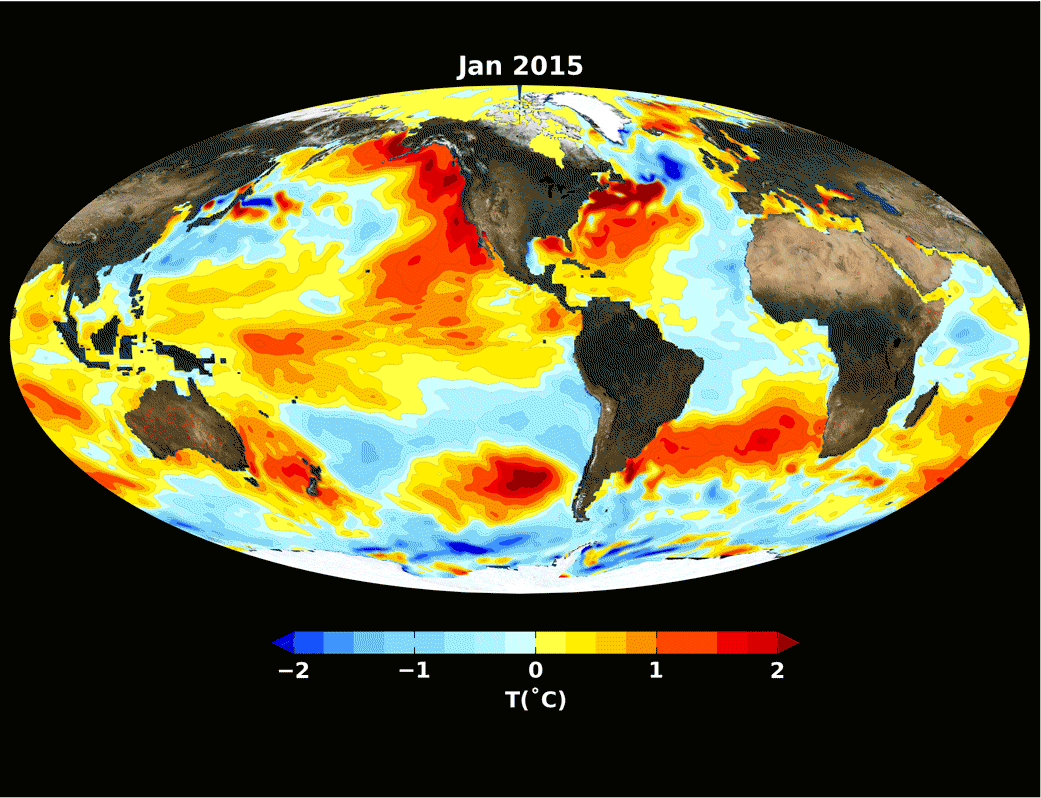Not too hot, not too cold – instead, water temperatures in the equatorial Pacific Ocean should be just around normal for the rest of 2016, according to forecasts from the Global Modeling and Assimilation Office, or GMAO. With these neutral conditions, scientists with the modeling center at NASA’s Goddard Space Flight Center say there is unlikely to be a La Niña event in late 2016.
Last winter saw an extremely strong El Niño event, in which warmer-than-normal water sloshed toward the eastern Pacific Ocean. Historically, some of the larger El Niño events are followed by a La Niña event, in which deep, colder-than-normal water surfaces in the eastern Pacific Ocean, off the coast of South America.
“We are consistently predicting a more neutral state, with no La Niña or El Niño later this year,” said Steven Pawson, chief of the GMAO. “Our September forecast continues to show the neutral conditions that have been predicted since the spring.”
As part of a research and development project, GMAO contributes experimental seasonal forecasts each month to the North American Multi-Model Ensemble (NMME) and other centers. MME produces a forecast by combining the individual forecasts of a number of participating institutions, which helps to reduce the uncertainty involved in forecasting events nine to twelve months in advance. The NMME prediction system delivers forecasts based on the National Oceanic and Atmospheric Administration (NOAA) operational schedule and is used by many operational forecasters in predicting El Niño and La Niña events.
For GMAO, the seasonal forecasts are one way to use NASA satellite data to improve near-term climate predictions of the Earth system.
“We’re really trying to bring as much NASA observational data as possible into these systems,” Pawson said.
The scientists with GMAO feed a range of NASA satellite data and other information into the seasonal forecast model to predict if an El Niño or La Niña event will occur in the nine months – information on the aerosols and ozone in the atmosphere, sea ice, winds, sea surface heights and temperatures, and more. The models are run on supercomputers at the NASA Center for Climate Simulation – 9 terabytes of data each month.
For much of this spring and summer, however, the Goddard group’s forecast of neutral conditions looked like an outlier. Most other forecasts originally called for a La Niña event, but then shifted to more neutral outlooks in August. But the GMAO forecasts produced in January 2016, which look nine months ahead, saw the Pacific Ocean reverting to normal temperatures after last year’s El Niño, and even getting a little colder than normal. Still, the water wouldn’t get cold enough to be considered a La Niña, according to the GMAO forecasts.
It’s not the first time in recent memory that GMAO was an outlier. “The big El Niño that peaked in November 2015, we actually began forecasting that back in March, and our forecast was in excellent agreement with the real event,” said Robin Kovach, a research scientist at GMAO. While the strength of the 2015-2016 El Niño predicted by the model seemed at first to be excessive, it was borne out in subsequent observations.
The GMAO models aren’t always right, though, Kovach said. In 2014 the group forecast a large El Niño that didn’t materialize.
“There’s a fair degree of uncertainty when you start predicting for nine months ahead,” Pawson said. But the group is constantly upgrading their systems, and is currently working to improve the resolution and bring in new types of satellite observations, such as soil moisture information from the Soil Moisture Active Passive mission, which launched in 2015.
GMAO scientists are also investigating how to incorporate observations of ocean color into the seasonal forecast model. Shades of green can tell researchers about how much phytoplankton is in a region, which in turn can provide information about fish populations.
“So if there’s another big El Niño in five years or so, we could be able to do online predictions of phytoplankton,” he said, “and help fishermen predict where fish might be.”
For more information, visit: https://gmao.gsfc.nasa.gov/
For NOAA’s El Niño and La Niña information and forecasts, visit: https://www.climate.gov/enso



























